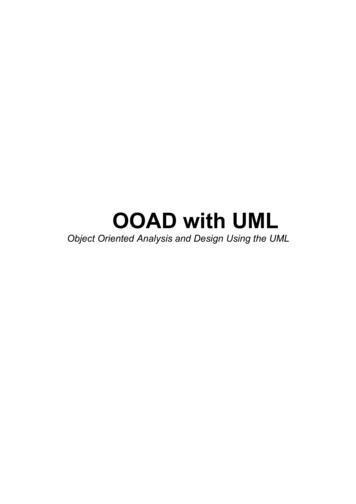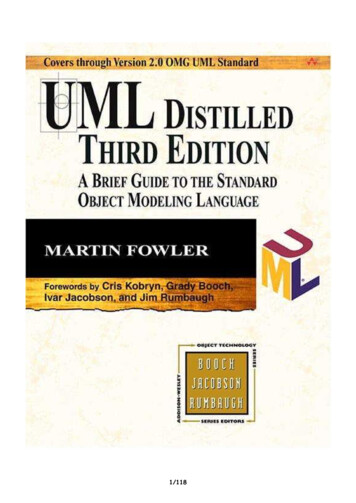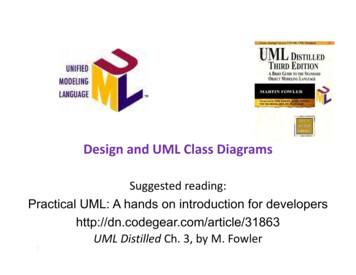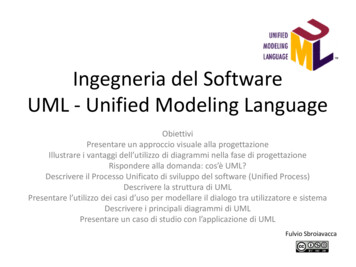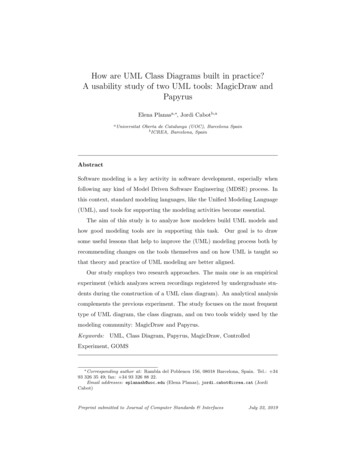
Transcription
Best Practices for Applying UML, Part IDarius Šilingas, Ph.D.Principal Trainer for MagicDraw UML
ContentSoftware Development and Modeling with UML.3Best Practices .4Best Practice #1: Apply a subset of UML relevant to your role .5Best Practice #2: Focus on the Most Valuable Modeling Artifacts .6Best Practice #3: Model in Multiple Abstraction Levels .12Best Practice #4: Choose Appropriate Level of Detail.15Best Practice #5: Model with Style .18About the author.20Services contacts .20 No Magic, Inc.2
Although UML notation is widely recognized as lingua franca for software development, many developers still lackskills for applying it efficiently. Methodologists, practitioners and tool vendors need to share their experience in order tofind out ways how to get the most use from modeling and avoid abusing it. With this whitepaper, we start a series of bestpractices in applying UML that are driven from No Magic expertise in multiple software development projects and buildingMagicDraw UML tool. We hope that they will help you to change the way you model and make it more efficient!Software Development and Modeling with UMLModeling is the core of modern software development. Like every larger engineering task, softwaredevelopment needs a plan. Models serve us as a plan and allow achieving multiple goals: Provide structure for problem solving; Experiment to explore multiple solutions; Furnish abstractions to manage complexity; Reduce time-to-market for business problem solutions; Decrease development costs; Manage the risk of mistakes.Only when developing very small systems, we may start from scratch and bypass modeling.You DON’T need modelingYou DO need modelingSmall one-person projects that do not need to bemaintained and will not be transferred tosomebody else might not require modeling.Large projects that involve large teams, are developed iteratively,and need to be maintained cannot be successful without models.In large projects modeling speeds up implementation while elevating quality and user satisfaction. We model in allsoftware development activities starting from business analysis and requirements definition to testing of the constructedsoftware system.Context diagramRequirements treesUse case scenariosVisual concept dictionaryDomain analysis modelWorkflow diagramsInformation structure and flowsTest case definitionsCode generation from UMLVisualization of code structureModel transformationsCode model analysisTest case action flowsImplementation architecturePackage structureInteraction scenariosDetailed data modelsUser interface “maps”Test case designTable 1– Applicability of UML Modeling SkillsSoftware systems are constantly growing in size and complexity, and without efficient modeling skills you cannot besuccessful. A Software Development Magazine Salary Survey in 2005 has revealed that the most important skills neededto produce quality projects and products are architecture modeling and design, which ranked higher than programming,QA, testing, and requirements management.Recently, we witness intense battles in the field of the software development process. While almost all approacheshave gone from the old waterfall approach to iterative development, they argue a lot about formality, roles, activities andartifacts, tools, and which workflows should be emphasized. No Magic, Inc.3
Figure 1 – Emphasis on Workflows by Different Softwate Development ProcessesSince modeling is the core of development and UML is the de facto standard as the modeling notation, all of thoseprocesses make use of UML. However, the way they use it differs quite a lot. RUP advocates a UML centric approach tosoftware design, which requires UML modeling tools. Agile methods – XP, Scrum, Lean – advocate informal modeling andusing whiteboards, paper, and simple text or drawing editors as a compliment to UML tools. While we are in none of thesecamps, we strongly believe that using modeling tool can help you a lot.Here is just a short list of helpful UML tool features: Create and maintain a repository of model data;Reuse model elements in multiple diagrams;Create nice diagrams using automated layout functions;Apply built in design patterns;Use automated model transformations;Generate documentation from your model;Analyze your model using automated tools;Enable teamwork within one modeling project.We believe these features are truly beneficial in all software development processes if you take a proactive approachto modeling. In the next section, we present 5 best practices for modeling with UML.Best PracticesExperience is the worst teacher – it always gives the test first and the instructions afterward.Let’s get some instructions before you apply UML in your projects – you can count on our experience, whichresulted in the best practices presented below. No Magic, Inc.4
Best Practice #1: Apply a subset of UML relevant to your role80%–20% rule: 80% of the users apply only 20% of the features.UML 2.0 defines 13 diagram types and each of them uses a bunch of UML elements. You can find many peoplearguing that UML has grown too large and too complex. Well, it definitely evolved and contains more modeling elements ifcompared to its original version. However, it is important to recognize that you don’t in most cases need the fullcapabilities of UML. The famous 80%–20% rule holds here as well – 80% of modelers will be fine with 20% of UML.Which 20% is yours is dictated by your role and that role’s need for specific UML modeling skills.Table 2 – Applicability of UML Modeling SkillsBusiness AnalystsSoftware ArchitectsCapture business processes in diagramsModel organizational structuresPerform analysis of domain conceptsPrepare use case-driven requirements model.Relate different architectural viewsTransition from business to system modelsDefine top-level components and package structuresManage modeling teamwork DevelopersQuality Assurance EngineersPrepare detailed class modelsModel interactions for use casesIntrospect existing systems by reversing and visualizing codeDesign OO, relational, and XML dataTransform class structures to database or XML schemas Analyze workflows for use casesPrepare action flows for test casesModel test dataModel interactions for unit and system testing Business analysts will mostly apply use case and activity diagrams for capturing processes and requirements, alsovery simple class diagrams for domain analysis and state diagrams for defining lifecycle of important business objects.They will need extensions of UML for modeling enterprise architecture concepts like organizational structure or businessgoals.Software architects will apply all UML diagrams, but they would not go into implementation details. Architects need tocapture overall system structure in high level concepts. In most cases, they will be fine with package, component, anddeployment diagrams; and will model only the most important classes and interactions. When building classical layeredsystems, they might use the robustness diagram – a simple extension of the UML class diagram – for identifying majorcomponents in interfaces, business logic, and data layers.Developers will not model all parts of the system, but they would go into low level implementation details on the mostimportant system parts, e.g. data structures. They use detailed class and interaction diagrams. Most probably, they willalso need UML extensions for capturing technology specific details like relational database structures or XML schemaelements.Quality assurance engineers need to analyze UML diagrams prepared by business and system analysts, and basetheir test cases on use case workflows. They will need object diagrams for modeling test data and activity diagrams formodeling test action flows and rules. For those who do more technical testing like unit testing (though in the most ofrecent approaches it is done by programmers), stress or load testing might need to model interactions using eithersequence or activity diagrams.The lesson learnedYou don’t need to know and use the complete UML specification. Learn and apply only the subset that is relevant toyour role!. No Magic, Inc.5
Best Practice #2: Focus on the Most Valuable Modeling ArtifactsThe cynic knows the price of everything and the value of nothing. [Oscar Wilde]The second best practice supplements the first one. Knowing what gives value to your role, you also need to knowwhat modeling artifacts have long-term value and need to be maintained. The others might be used for instant needs andthrown away later. Understanding this is really important, since trying to keep too many irrelevant modeling artifactssynchronized with actual source code quickly becomes a pain in the archive. We believe this synchronizationheadache makes many people think they don’t need modeling tools and are fine with whiteboards. But they soon get lostin whiteboard discontinuities.However, analysis model artifacts are of high value and should be consistently modeled and maintained, includinganalysis artifacts such as: Domain entity relationship (ER) class diagrams;Use case models;Activity diagrams for use case scenarios.Business analysts perform domain analysis by modeling domain entities and their relationships using simplified classdiagrams. These diagrams serve as a visual vocabulary of concepts. They are also a starting point for the design leveldata model.MagicDraw tipsMagicDraw UML tool can even generate a dictionary from class descriptions in HTML format if youprovide concise descriptions for modeled concepts.ReaderPenalty10.1makesgiven for overdue0.*Reservation1is given for0.1inactivatesLoan11Return0.10.*books1Itemis child ofclassified by0.*1.*0.*Category0.1Figure 2 – Domain ER diagram for library management systemThe most popular way to analyze functional requirements is the use case method. It starts by identifying user roles –actors – and associating them to their interactions with system – use cases. Many business analysts even start with UseCases as the best way to capture and document user requirements. No Magic, Inc.6
MagicDraw tipsWith tools such as MagicDraw, you can even document use case properties like pre- and post-conditions,assumptions, interaction scenarios, and generate a formal, presentable use case document from yourmodel, that can be reviewed by and shared with the business stakeholders.Abstract use case implementation logic is either defined in text or, for more complex cases, by creating activitydiagrams visualizing activity flows for primary and secondary use case scenarios.MagicDraw tipsAs an example, with MagicDraw you can hyperlink use cases to the activity diagrams modeling theirscenarios and assign activity diagrams as use case primary and secondary scenarios, which enablesincluding them in generated use case documents. You can decompose activity diagram elements usinghyperlinks to detailed diagrams.Find itemMake item's reservation include Identify readerReaderReview reader's historyShow list ofloaned items include Select returned itemsRegister items' returnextension points[overdue]overduePenalize for overdue[on time] extend (overdue)LibrarianRegister items' loanRecord return dataPenalize for overdueFigure 3 – Use case model artifacts: use case diagram and activity diagram presenting scenarios for a particular use case Register items returnTechnical design model artifacts may be roughly divided into three value-based groups: High value ( ) – should be modeled and maintained using UML tools;Medium value ( ) – may be maintained or not;Low value ( ) – should be used for communication and thrown away. – High value design models Top level structural decomposition of software and hardware environments- UML package, component, robustness and deployment diagramsTop level package dependency diagrams- UML package diagramData model- UML class diagrams in multiple level of abstraction and detailsInterfaces for system layers / components / subsystems- UML class and component diagramsDynamic models for interactions implementing main usage scenarios- UML activity and sequence diagrams (details, e.g. parameter values, are often left out) No Magic, Inc.7
System architects need to bridge the gap between analysis and design. If they are designing layered systems, theymay apply robustness analysis, which is based on a simple extension of the class diagram. It makes use of only fourelements – actors, boundaries (user or system interfaces), controls (business logic), and entities (data). While entities aremore or less identified by the domain ER analysis, the challenge is to analyze actors and use cases, find the systemboundaries, and connect them to data entities through controls.Seeing the forest before going inside gure 4 – Robustness analysis for identifying major components in a layered architectureArchitects need to provide the top-level decomposition of software system packages. Modeling dependencies are veryimportant in this case since they set the rules for class responsibilities and interactions and help avoid evil effects likeinappropriate coupling and cyclic dependencies. The tools for showing decomposition including dependencies are thepackage diagram and the component diagram.Divide and rule! - a strategy used by ancient Roman inpersistenceFigure 5 – Package dependency diagram No Magic, Inc.8
While the package diagram allows a logical grouping of implementation classes, the component diagram showssystem level functional elements. Usually, package and component diagrams leave out utility or library packages.Although packages should be component driven, one package may include multiple components and vice versa. Forexample, a component might span several packages depending on its size. Component diagrams may also focus on theprovided and required components, and on connecting the components together.It is also important to show how implemented software will be deployed in the hardware and software environment.For this purpose, architects apply deployment diagrams. In UML 1.x, deployment diagrams allowed nesting componentson deployment nodes. In UML 2.0, this has been changed, and instead of components, you need to use artifacts that area physical manifestation of software components. It is a rather common practice to create technology specific UMLextension profiles. Profiles enable one to indicate a ‘type’ of an artifact, e.g. EJB-JAR , and preferably to assign anintuitive icon, which can replace the standard rectangle shape, e.g. a database icon.Web ClientJ2EE Application ServerHTTP executable Internet Borwser artifact JSP pages EJB-JAR EJBServices.jarLocal ClientTCP/IPJDBC JAR AdminGUI.jarDatabase Server EJB-JAR EJBEntities.jar database MagicLibrary.mdbFigure 6 – Top level deployment diagramOnce architects have decomposed the system into packages, components, and deployment artifacts following thelayered architecture principle, the next important thing is to specify the contracts between layers. The most importantpiece here is the method specifications for business logic services, and also for data persistence services if they are notreused. The first step can be done using class rvice findUsers( query : String ) : List findItems( query : String ) : List findItems( query : String, cateory : Category ) : ListServiceFactory implement getSearchService() : SearchService getReservationService() : ReservationService getAdministrationService() : AdministrationService getRegistrationService() : RegistrationServiceReservationService makeItemReservation( customer : Customer, item : Item ) : Loan implement canceltemReservation( reservation : Loan ) : void create RegistrationService registerLoaned( loan : Loan ) : Loan registerReturned( loan : Loan ) : Loan implement AdministrationService addCustomer( customer : Customer ) : Customer updateCustomer( customer : Customer ) : Customer removeCustomer( customer : Customer ) : boolean addItem( item : Item, categories : List ) : Item updateItem( Item : Item ) : Item removeItem( item : Item ) : Item implement ationServiceRMIAdministrationServiceFigure 7 – Interface specifications for business logic layer components No Magic, Inc.9
However, using only static class diagrams is not sufficient – you may miss some responsibilities or decompose theminappropriately. Therefore you need to model the dynamic behavior for use case scenarios in order to validate and justifyclass structures. Applying interaction diagrams – sequence or communication – help in find new methods in existingclasses, and in finding new classes for specific responsibilities. Interaction driven modeling is actually a very efficientmethod, and is the modeling counterpart for test driven programming.MagicDraw TipsMagicDraw allows creating new classifiers and adding new methods to existing ones when modelinginteractions. You can also easily drag and drop classes to create typed lifelines. boundary control entity control : ReaderProfile: LoanService: Loan: NotificationService: Readerreflogin1: select reservations for canceling2: cancelReservations(-)loop3: cancelReservation(-)[for earch cancelled reservation ]4: inactivate()5: getWaitingUser(-)6: notifyUser(-, -)7: true8:Figure 8 – Interaction diagram for implementing specific use case scenario – Medium value design models Structure of UI classes- UML class diagram, might be extended for specific technologyUI screen transition schema- UML state or class diagramReusable implementation solutions- UML class, object, sequence diagramsLogic of important algorithms- UML activity or sequence diagrams No Magic, Inc.10
During technical design activities, if you go up the layers of the software system, the stability decreases. Detailedmodels for user interface layers are volatile during design phase – they change a lot, and throwaway prototyping is anapproach used. Whether this method is used or not, is it still valuable to model high-level structures of user interfaceelements without going into details. redirect server page FirstLoad client page IncorrectLogin builds client page UserLogin build form LoginForm submit {parameters LoginID, Password} server page Login build client page MemberPageFigure 9 – Structure of Web UI ClassesIt is rather difficult to get precise requirements for the system without prototyping its user interface and sketching itsnavigation schemas. Thus, drawing and maintaining a navigation schema for a system is also a highly useful part of yourmodeling toolkit. You should apply state diagrams for this task.loginlogout[results 1] / show not found messagebackItem Browsersearch queryselect category / refreshback[results 1]select Item[results 1]Search ListItem Detailsmake reservationReservation ListFigure 10 – User Interface Dialog MapIf you go deeper into implementation, modeling is also essential, and it can also be accomplished using UML tools.For example, finding the methods for implementation classes can be accomplished using test-driven programming, whichforces you to write unit tests and only then implement the class. Having a model of the tests and test cases helps navigate No Magic, Inc.11
through the test process. The testing functionality has excellent support in modern IDE tools. However, UML modelsillustrating the logic of important algorithms or reusable implementation solutions may also be very helpful for variouspurposes – analysis, learning, and documentation. – Low value design modelsDetailed implementation level class modelsqDependency diagrams for “deep” inner packages and classesDetailed user interface modelsInteraction diagrams that model all details of implementationTrivial activity or state diagrams During technical design phase, detailed models change frequently, thus it is better to model, implement, and analyzethem in conjunction with programming IDE tools. Most of the technical models can be reversed and visualizedautomatically from source code using code reverse engineering tools.MagicDraw TipsMagicDraw UML supports forward and reverse engineering of various types of code: Java, C , C#,relational databases, XML schemas. It also provides multiple model visualization tools that in anautomated way create multiple diagram types such as package dependency, class hierarchy, and Javasequence diagrams.The lesson learnedModel artifacts may be difficult to maintain, thus you need to focus on the most valuable ones. Draw and maintainthe value artifacts using UML tools, make your selection of value artifacts that you find useful in your projects,and don’t use for sketching but don’t worry about maintaining value artifacts. Maximize your time and your efforts inthis way.Best Practice #3: Model in Multiple Abstraction LevelsAbstraction is the process of reducing the information content of a concept, typically inorder to retain only information that is relevant for a particular purpose [Wikipedia]Abstraction is the thought process wherein ideas are distanced from objects [Wikipedia]We model to furnish abstractions in order to manage complexities. Usually there are several levels of abstractions thatneed to be modeled. The following abstraction levels are usually defined: Analysis Model aka Computation Independent Model (CIM);Design Model aka Platform Independent Model (PIM);Implementation Model aka Platform Specific Model (PSM).In your UML modeling tool, you should structure your model so that these abstraction levels were clearly separated,easily maintained, and backtracked. Let us show an example of traveling through these three abstraction levels.The conceptual library management system ER diagram is an example of the Analysis Model (CIM). It shows theconcepts that exist in the library system independently of whether it is managed manually of with software system. Thelinks show logical relationships, and we do not model attributes. Even if attributes were modeled, their data types wouldnot be assigned. No Magic, Inc.12
ReaderPenalty10.1makesgiven for overdue0.*Reservation1is given for0.1inactivatesLoan11Return0.10.*books1Itemis child ofclassified by0.*1.*0.*Category0.1Figure 11 – Analysis model of library concepts (CIM)When designing the software system, we need to derive a detailed data model. It has to be conformant with theanalysis model, but some restructuring may be applied based on design decisions. For example, the diagram belowillustrates a design model derived from the previous analysis model by making the following changes: Attributes with UML data types were specified for each class;Concepts of Reservation, Loan, and Return were merged into one class Loan;Two specific subclasses of Item – Book and AudioRecord – were added.This model already defines the complete data structure, but is not technology specific – it’s pure object orientedstructure with UML data types, thus not specific to any particular programming language like Java or data storagetechnology, relational database, or XML.ReaderPenalty-reader1-firstName : String-lastName : String-email : String-suspendedUntil : date.1-loaner1-overdueLoanLoan-dateReserved : date-dateLoaned : date null-dateReturned : date nullItem-book1-title : StringCategory0.* -categories1.* -name : String-description : String-price : floatBook-ISBN : String-numberOfPages : int-edition : int-published : date-childs0.*-description : String-parent0.1AudioRecord-artist : String-label : String-released : dateFigure 12 – Design model of a library data structure (PIM)The next step is to derive the platform specific model, which contains technology specific details and has enoughprecision for generating executable code. For this kind of modeling, you need profiles with extensions to the UML No Magic, Inc.13
language, which are technology independent. The example below shows a relational database structure, whichcorresponds to the design model, with the following changes: Classes were assigned stereotypes table ;UML data types were changed to SQL data types and multiplicities were identified;Primary and foreign key fields were added to classes;The associations were assigned stereotype FK with properties indicated field mapping;The many-to-many association was changed into intermediate table;The generalization relationships were turned into foreign keys. table Item PK -id Item : integer-title : varchar-description : varchar-price : float table Category Item-fk Categoryid Category : integer-fk Itemid Item : integer FK . FK table Category PK -id Category : integer-name : varchar-description : varchar-fk Categoryid Category : integer FK FK table Loan PK -id Loan : integer-dateReserved : date-dateLoaned : date null-dateReturned : date null-fk Readerid Reader : integer [1]-fk Itemid Item : integer [1] table Reader FK PK -id Reader : integer-firstName : varchar-lastName : varchar-birthday : date-email : varchar FK table Penalty PK -id Penalty : integer-suspendedUntil : date-fk Readerid Reader : integer [1]-fk Loanid Loan : integer [1] FK Figure 13 – Implementation model of library relational database schema (PSM)Although it is possible to model the PSM manually, it is advised to use automated transformations. However, usingtransformations is a topic of another best practice in the upcoming whitepaper.The lesson learnedYou can model at different abstraction levels. However, it is crucial to decide how many abstraction levels you needfor you project – some will be fine with one, but the most will at least require two if not three. Clearly separatingabstraction levels in your model projects facilitate maintaining and backtracking related elements. No Magic, Inc.14
Best Practice #4: Choose Appropriate Level of DetailSometimes less is more.Figure 14 – Diagrams overloaded with details are difficult to read and understandLevel of abstraction dictates the level of detail. However, with UML modeling tools even within one abstraction levelyou may choose to show different levels of details. The purpose of what you want to show should drive the choice.Irrelevant elements that can be guessed implicitly should be left out. A common technique is to show a diagram withoutdetails of elements but showing the most important relationships between them. Then you can have additional diagramsthat focus on the details of specific element.Let’s go through an example of multiple levels of details so that you can decide, which level is the most appropriate foryou.Step 1Measurable getter getLenght() : floatNaming convention indicates method purpose, thus stereotypecan be hidden.MeasurableShapeTrivial conventional methods, e.g. setters and getters, toString(),can be hidden compareTo( obj : Object ) : intPolygon Polygon( points : List ) hasPoints() : int getPoint( index : int ) : Point getLength() : float toString() : StringLine Line( start : Point, end : Point ) getStart() : Point getEnd() : Point getLength() : float toString() : String-startPoint-x : int-end -y : int Point( x : int, y : int ) getX() : int getY() : int setX( x : int ) : void setY( y : int ) : void-points equals( obj : Object ) : boolean distanceTo( point : Point ) : float2.*{ordered} toString() : StringFigure 15 – Level of Details, Step 1: all implementation details are shown No Magic, Inc.15
MeasurableStep 2 getLenght() : floatMeasurableShape compareTo( obj : Object ) : intLinePolygon Line( start : Point, end : Point ) getLength() : float. Polygon( points : List ) hasPoints() : int getPoint( index : int ) : Point getLength() : float.Associations with roles andmultiplicities can beconverted intro attributes.Point-start-x : int-end -y : int-points2.* Point( x : int, y : int ){ordered} distanceTo( point : Point ) : float.Figure 16 – Level of detail, step 2: irrelevant elements are removedStep 3Measurable getLenght() : floatAssociations with roles andmultiplicities can beconverted intro attributes.MeasurableShape compareTo( obj : Object ) : intLine-start : Point-end : Point Line( start : Point, end : Point ) getLength() : float.Polygon-points : Point [2.*]{ordered} Polygon( points : List ) hasPoints() : int getPoint( index : int ) : Point getLength() : float.Figure 17 – Level of detail, step 3: unimportant associations are turned into attributes No Magic, Inc.16
Step ints2.* {ordered}PointFigure 18 – Level of details, step 4: only class and interface symbols and relationships between them are shownAs you probably agree, removing irrelevant details allows focusing on the essential design elements, which makesdiagram easier to read and understand.It is very important to choose appropriate level of
Best Practice #1: Apply a subset of UML relevant to your role 80%-20% rule: 80% of the users apply only 20% of the features. UML 2.0 defines 13 diagram types and each of them uses a bunch of UML elements. You can find many people arguing that UML has grown too large and too complex. Well, it definitely evolved and contains more modeling .

